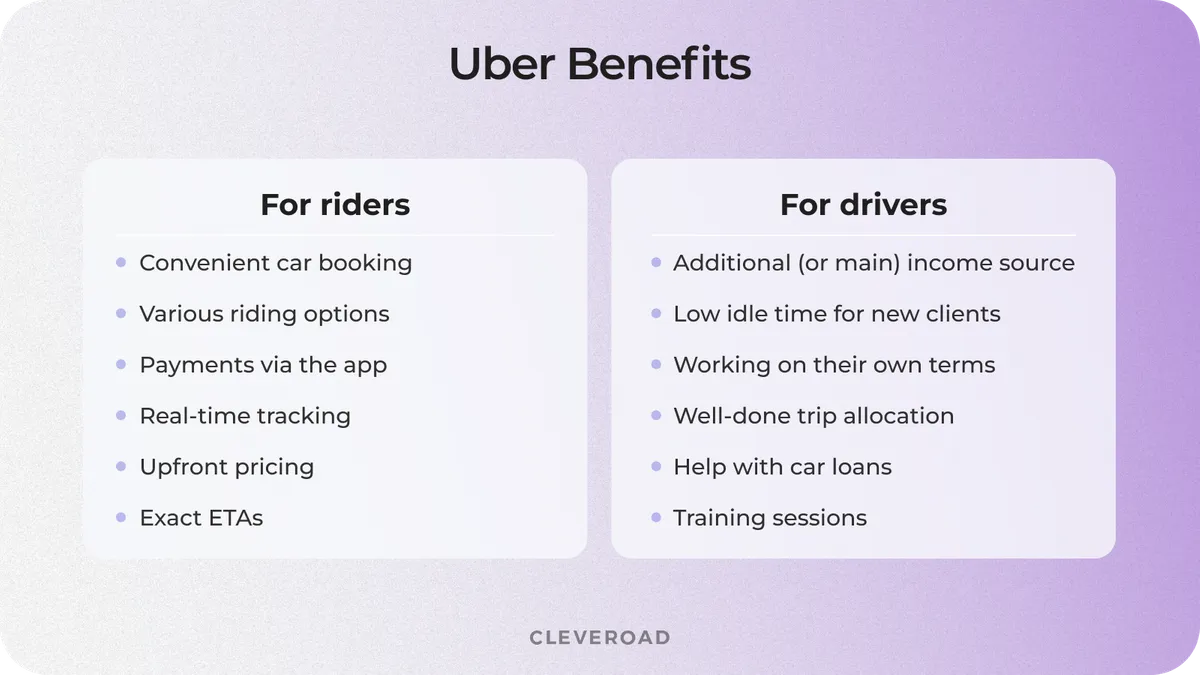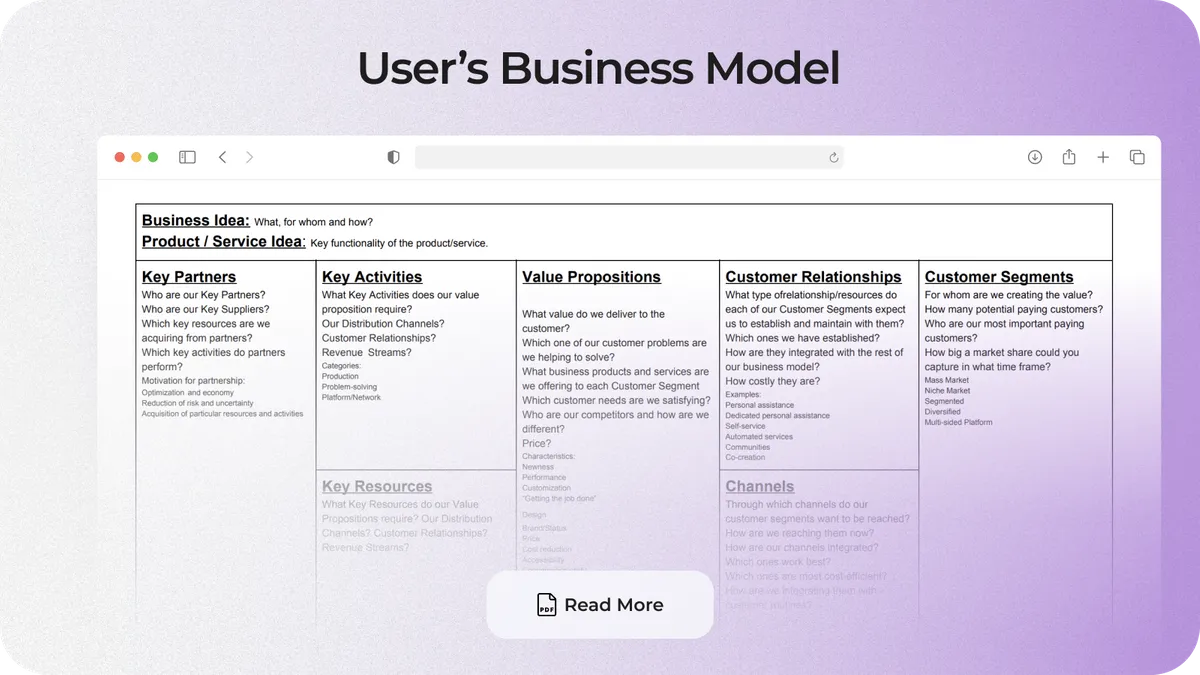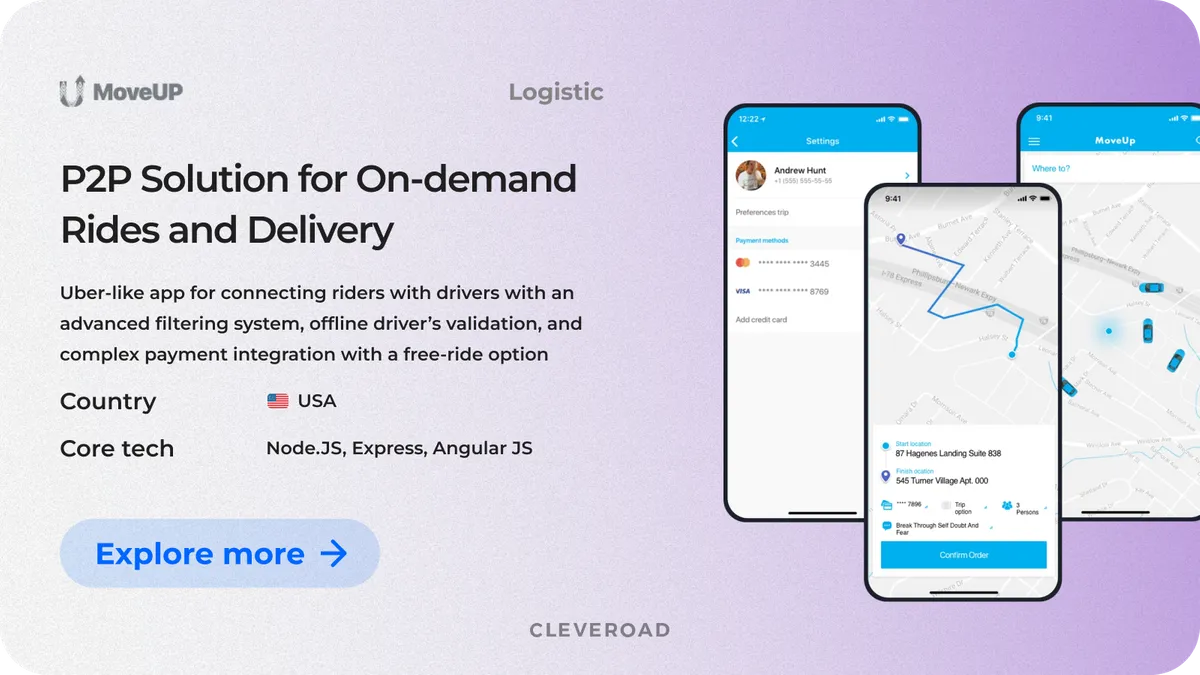How to Start Uber-Like Business: Building Your Own Uber for X Platform
Updated 21 Jun 2025
19 Min
34760 Views
Today’s Uber-like apps don’t always have anything to do with taxi services. They’re everywhere in various spheres of life. On-demand platforms are taking over our everyday lives. And each service somehow has its own base of loyal and engaged users. For example, a babysitting app that comes in handy for many users.
So what’s the secret of Uber for X's success? How to start an Uber business, and which model to choose? What is Uber's business model canvas? All that and a bit more about Uber-like services, starting an Uber business of your own, and making a go of it – in our guide. Let’s #MoveForward!
What Is Uber for X?
In Uber for X, ‘X’ means any deliverable service in the market. How does it work? First, customers connect with service providers by placing orders via a mobile app or website. Then, the provider looks through and accepts the request and delivers the service if everything works for them.
Starting Uber business, connecting buyers and service providers sometimes takes more than pressing a button. But that’s still the main concept of it. Mostly, Uber for X platforms have a variety of in-built filters, making the search process very fast and convenient.
For example, to get from point A to point B, all Uber users have to do is place a request and wait for a match with a driver. A few minutes – and the car’s right at the corner.
Now, let’s find out what actually makes the service this fast, convenient, and affordable.
Business model explanation
Uber for X business model is a so-called two-sided marketplace. Riders generate the demand, drivers supply it, and Uber acts as the facilitator, providing a convenient and easy-to-use platform.
As no third party prevents these two sides from working with each other, the platform collects a fee from both customers and service providers. (We’re going to take a closer look at their revenue sources later on). This self-managed dynamic is a key strength of any Uber-like taxi model that thrives on scalability and autonomy.
What's remarkable is that Uber doesn’t hire drivers. Instead, it builds a decentralized service model, a core principle for anyone planning to build an app like Uber. Drivers choose their own schedule and the number of hours they're ready to work, and they remain under nominal control. Drivers have the right to accept or decline the contract terms, and they can choose what period to collaborate with Uber (Source: ScienceDirect).
As for now, more and more people are turning to starting an Uber business instead of good old city services, largely because of its feature-rich app, clear pricing, and flexible operations. Uber offers a unique value proposition to both parties, which makes the service affordable to use and profitable enough to work for.
Besides, with each next driver or rider joining the platform, the service works better and better for existing users. For Uber's case, the more drivers and riders they have, the better pickup times and the lower prices are, customers write better reviews, and all this ultimately leads to increased revenues for the marketplace. This ecosystem growth directly supports the main objectives of your business if you're entering the ride-hailing industry, increasing platform utility and decreasing cost per ride.

Reasons why riders choose Uber
How to Start a Taxi Business Like Uber?
Let’s consider the step-by-step plan to start your own taxi business and build a sustainable product in the competitive taxi market:
- Step 1. Research the market and identify your niche
- Step 2. Define your business goals
- Step 3. Identify the buyer's persona and map out the consumer's journey
- Step 4. Get acquainted with the legal matters
- Step 5. Select a reliable technical partner
- Step 6. Plan your budget and initial investments
- Step 7. Define the required MVP features
- Step 8. Work out your marketing and promotion strategies
And now, let’s review these steps in more detail.
Step 1. Define your business goals
Once your niche is set, focus on defining your Unique Selling Proposition (USP). What makes your offer better or different from what’s already out there? This could be pricing, convenience, specialized features, or customer service. A strong USP will help you stand out.
Also, clarify what you want to achieve with your business. Align on core goals, whether it's capturing a certain market share, delivering a top-rated user experience, or hitting specific revenue milestones. These goals will shape your product development and marketing strategies from day one.
Step 2. Research the market and identify your niche
To understand how to start your own Uber business, begin with thorough market research. You should determine your target audience, analyze risks, and evaluate potential investment returns. It helps avoid early missteps and gives you a clearer picture of what you're stepping into.
Next, assess your competitors. The demand for on-demand services continues to rise, which means you’ll face strong players. Analyze their features, pricing, and user experience to spot gaps and opportunities you can leverage.
Use these insights to decide which service niche you want to enter. While ride-hailing is the classic model, other promising directions include food delivery, home services, healthcare, and more. Choose the field that aligns with your strengths and has clear market potential. Whether you're launching an online taxi service or expanding an existing taxi business, thorough research defines your success.
Our software development for startups services will help conduct market research and make an application that will fit both your business goals and market demands
Step 3. Form a USP and define business goals
Buyer personas are images of your ideal customers based on research. They help you focus your time on qualified leads, guide product development to meet the needs of your target customers, and align all the work in your organization. Buyer personas’ information is essential to designing a successful app that truly solves your customers' pain points, not just mimics competitors.
To identify buyer personas to start your own Uber business, you must go through the following steps:
- Research demographic information. Determine the age, gender, and geographic location of your target customers.
- Identify issues. Find out what pains your buyers will be able to solve with your solution.
- Identify their priorities. You should also find out how ready your target audience is for the solution you will provide them, to see if it will be in demand.
- Find out about their concerns. Research why customers may doubt that your solution would be best for them, so you can convince them to choose your service.
- Identify their channels of information. Find out what sources your audience can get data about your app from to have insight into their sales channels.
- Identify their buying process. Map out the buyer's journey to understand their steps in the decision-making phase of choosing a service.
Step 4. Mind the legal matters
The legal entity defines how big the company's going to be (and may be). Currently, the choice for a traditional taxi booking app service lies between a general partnership and a limited liability company.
- A general partnership is the best business structure for a small-scale service company. It works for people who are just starting out and have a moderate amount of seed money.
- In case the company is to grow large and serve both corporate and individual clients all over the USA or other countries, an LLC (Limited Liability Company) is a perfect choice.
Limited liability companies are simpler and more flexible to operate, and if something goes wrong, it's only the invested money that will be at risk, not the partners. This flexibility makes it easier to register a taxi service company or a taxi business with one car, if you're testing the market before scaling.
Step 5. Select the reliable IT partner
An experienced mobile app development services provider will help you understand how to start your own Uber business and create a competitive software solution for you. The most cost-effective solution is to cooperate with an outsourced IT partner.
When choosing a tech vendor, pay attention to the following points:
- Provider’s region and team’s hourly rate
- Customer reviews on platforms such as Clutch and GoodFirms
- Portfolio with previous development cases
- Information on the blog and website of the mobile app development company
- Understanding Uber like app development, legal compliance, and competitive edge in the taxi mobile app development field
- Transparent about app development process, including team roles, communication workflows, and sprint cycles
- Understanding how to develop solutions that adhere legal compliance
Cleveroad has in-depth experience in providing software development services for SMBs and startups. To demonstrate our expertise, we’ll present to you our recent case.
We provided MVP development services to our client from Switzerland, DGTL Ventures, a system integration consultancy. DGTL Ventures helps enterprise clients like BMW Group, AXA Group, TUI, Robert BOSCH, and Henkel explore, implement, and scale digital adoption solutions.
In parallel with their core business, DGTL Ventures launched a new startup initiative, Hairdressers, a platform targeting the freelance beauty industry. The product is Switzerland’s first digital solution that connects freelance hairdressers with salons offering chair rental services.
Our client needed a technical partner to develop a full MVP version of the Hairdressers platform from scratch, ensuring better performance, quality, and budget alignment. We began by conducting a Solution Design Workshop and proposed several collaboration models to fit the client’s goals, from minimal implementation setups to long-term cooperation options.
Durent our collaboration, we've delivered a fast launch of the platform. We provided:
- A simple, intuitive UI/UX based on the Elstar Tailwind Template Kit to reduce design time and costs
- A scalable web platform and admin portal, built with performance and stability in mind
- Full DevOps configuration to ensure smooth deployment and security
As a result, our client received a secure, well-architected MVP of an on-demand chair booking platform for hairdressers that met all client requirements, the Uber for X business model, and launch deadlines. Our engineering approach saved costs, optimized timelines, and exceeded expectations. The client received not just a product but a trusted team, and now confidently recommends Cleveroad as a technical partner to others in their network.
Gilles Fransen, CEO of DGTL Ventures, shares his experience working with Cleveroad:
Gilles Fransen, CEO of DGTL Ventures: Testimonial on Cleveroad's Software Development Expertise
Step 6. Plan your budget
No less important than a step to successfully start your own Uber business is budget planning. This way, you can anticipate your expenses and prevent unexpected costs from impairing your plans. Budgeting early gives you clarity on the cost of app development, backend infrastructure, and team scaling needs. To do this, it is worth considering what processes you will need to invest in:
- Conducting market and target audience research. Analyze competitors and customer behavior to understand your niche and validate demand.
- Preparation throughout the Decision, Design, and Discovery Phases. Your vendor aligns your goals with technical feasibility, defines core app functionality, and clarifies project scope.
- UI/UX design. Your IT software development partner creates user-friendly, intuitive interfaces tailored to your target audience’s habits and expectations.
- Development and testing. Your software provider builds the app’s features, infrastructure, and integrations while ensuring performance and reliability through testing.
- Release and technical support. Your vendor launches your Uber-like service on app stores and maintains its stability with regular updates and bug fixes.
- Advertising and marketing. You should attract new users and drivers through digital campaigns, branding, and promotions tailored to your market.
To help you with accurate budget planning, Cleveroad offers a free Solution Workshop tailored to Uber-like app development. This session is essential for matching your business goals with the right technical approach. We’ll explore your operational challenges, outline a feature set, and select an optimal tech stack. After the workshop, you’ll receive a rough cost estimate, so you can make informed investment decisions from the very beginning. Such an approach is especially helpful if you plan to start with an MVP, keeping early development lean while proving market traction.
Step 7. Think of MVP features
An on-demand service is quite an expensive project to build, especially when it comes to starting an Uber business. It typically includes three core components: an admin panel, an app for drivers, and an app for customers. Exactly what you'd expect from a taxi booking app like Uber. So, if you’re on a tight budget, the best solution is to give a task to app developers to launch an MVP first.
- The app for taxi drivers includes the following necessary features: delivery reports, route optimization, ‘accept/cancel order’ screen, earnings screen, etc.
- As for customers, they take advantage of features like ride cost estimation, geolocation & routing, direct app payments, etc.
- Finally, the admin panel involves managing both users and drives, payment, promotions, and more.
Your software provider will help you identify the list of MVP features for your app that will suit your app business goals and meet your business needs.
We’ve explained how to build a minimum viable product. Read our article to learn more
Step 8. Work out your marketing and promotion strategies
No matter how advanced your features are, without marketing your taxi service company like Uber, you won’t reach your target audience. What’s the use of a service no one has heard about? Remember that when it comes to advertising, everything's fair. If you have some extra money, you may start with distributing handbills or advert spots in newspapers, TV, and radio. But if there's an issue with finances, choose the World Wide Web as the main promotional channel.
Thanks to influencer marketing, social networks like Facebook, Twitter, Instagram, YouTube, and Google ads, when it comes to online promotion, the possibilities are endless.
Uber-like Business Ideas
Uber for X models work for various business categories, showing the best result when:
- People need quick and quality help with tasks they don't have time for (walking a dog, house-cleaning, make-up, or hairdressing);
- Existing services work too slowly, so there's a need for an alternative (food delivery, trip accommodation, or booking a massage therapist).
But what are the industries in which starting an Uber business app idea works best?
Food delivery
Modern busy people value food quality and taste, and how fast it’s cooked and delivered. Besides, many are concerned with eating healthily. All that allows Uber for X platforms to rise and shine.
For instance, Glovo (a Spanish startup) promises to deliver chargers, smoothies, groceries, and food from city restaurants in just a few minutes. The service also delivers food items from local supermarkets and grocery stores, charging 30% of the total cost of the order.
Here are more examples of successful food delivery solutions and their profitability:
- Uber Eats. Uber Eats, a global leader in on-demand food delivery operating across multiple countries, generated $13.75 billion in delivery revenue in 2024 (Source: USEC).
- Zomato. Zomato is a prominent food delivery platform primarily serving India and several international markets. According to Scribd, the company reported $1.47 billion in 2024, representing a strong 71% year-on-year growth.
- Instacart. Instacart, a leading US-based grocery delivery and pickup service, achieved total revenue of $3.378 billion for 2024, reflecting an 11% annual increase (Source: USEC).
- DoorDash. DoorDash, the largest food delivery platform in the United States, reported total revenue for fiscal year 2024 was $10.722 billion, a 24% increase over 2023.
Household chores
Office workers, managers, and young parents barely have time for cooking (or using one of the delivery services). Not to mention house duties like laundry, bathroom cleaning, vacuuming, dog walking, etc. Once these people reach a certain level of income, they're looking for someone to take care of their homes, chores, pet duties, and even laundry.
Wag! is a hit-parade platform that helps users find dog walkers when they don't have time to walk their pets. You just book a person who is qualified enough for 'dogsitting' right away or beforehand. Besides, you can always track the dog using a GPS tracker, or just ask the person to send some pictures.
Let’s look at other profitable household chores solutions:
- Hello Alfred. Hello Alfred is a US-based home management platform that helps users outsource everyday household chores like cleaning, grocery shopping, and laundry. Zippa reported that Hello Alfred raised $9,2 million in revenue in 2024.
- TaskRabbit. TaskRabbit is an online marketplace owned by IKEA that connects users with local freelancers for various housekeeping and handyman services. According to Growjo, TaskRabbit's revenue in 2025 was $343.4 million.
- Rover. Rover, a leading online marketplace for dog walking, pet sitting, and other pet services, generated $210 million Trailing Twelve-Month (TTM) revenue as of mid‑2025, CMC reported.
- Urbansitter. UrbanSitter is an online platform connecting parents with trusted babysitters and nannies. Growjo estimates UrbanSitter’s annual revenue at $107.7 million.
Medical consulting
Finding a personal doctor is very challenging, but on-demand platforms make the lives of wandering patients much easier. Sure, doctors can't yet make a diagnosis without proper tests, still, a plain consultation is something apps and websites work for.
DoctorOnDemand's probably the best-known platform that allows people to consult with a physician, pediatrician, or psychologist via video calls. This is a fast-growing trend in digital healthcare, not unlike taxi app development models that scale user-provider connections instantly. Moreover, they offer treatment programs and plan to help manage specific health issues.
One of the best business ideas, such as start your own Uber for medical consulting services, includes Pager. Pager is a healthcare technology company that provides AI-powered care navigation, telemedicine, and care coordination services for health plans, providers, and employers. Kona Equity reports Pager’s annual revenue as $73.5 million.
Transportation and logistics
Uber, Lyft, Bolt (formerly Taxify), and other on-demand car services are doing a great job of driving people to places. But when it comes to more–or–less sophisticated cargo, any UberLUX car won't be enough. Luckily, there are also Ubers for logistics (Lalamove), packages.
Lalamove delivers cargo with lorries, vans, and 5.5-ton trucks. It's an Asian company that competes with big players and does it well. What's more, they are not shy to show their rates clearly on their website, including the list of available vehicles. According to Longport, Lalamove's total revenue in the first half of 2024 was $709 million USD, an 18.2% year-on-year increase.
If you start your own Uber business, you’ll offer an entirely automated way of interaction. Passengers don't communicate with dispatchers to get a ride, cashless payments, a feedback system, and customer support, as all these services are available through the app or website.
How to Run Uber Business Profitably: Choosing a Suitable Revenue Model
You will surely think about how to start a company like Uber and make it profitable. Among the revenue strategies are:
Commission-based revenue
After the passenger pays for the ride, the Uber app transfers the funds to the driver, charging a commission of 15-30% (depending on the region) in advance. This model is used for Uber Taxi Services.
Uber Eats also charges a 30% commission from the restaurant partners for each order. This commission-based setup is especially effective in platforms where drivers and passengers interact regularly and value seamless payment flow.
Delivery-based revenue
There are three types of fees: pickup fee, delivery fee, and distance fee (per mile). If you're analyzing “how much does it cost to adopt this strategy?”, remember it scales with your delivery zones.
Amounts may vary depending on locations, distances, and availability of drivers. And Uber will take 25% of the total sum. Besides that, for orders cheaper than $12, Uber will charge a $2 fee, which they call a "small orders fee”. You can use this model to create an app like Uber Eats.
Advertising revenue
Uber uses a method of earning income from exclusive promotions on the app. For example, Uber Eats offers to pay special commissions and fees to be placed higher on the list and attract more customers.
For those estimating the cost to develop an app with similar advertising capabilities, this model offers solid long-term ROI by leveraging user attention. In addition, Uber promotes sponsored listings and banner ads across the platform, allowing brands and partners to reach targeted users directly within the app experience.
Subscription-based revenue
Uber also monetizes its platform through a subscription service called Uber One. Members enjoy benefits such as free delivery on eligible orders and exclusive discounts at participating restaurants.
The subscription also provides cashback in the form of Uber Cash on qualifying deliveries, along with reduced fares on most rides. This approach encourages customer loyalty while generating steady, recurring revenue. It also simplifies the decision to book a ride, especially for users who travel frequently and want consistent perks.
Uber Business Model Canvas
Now, if you are wondering how to start your own Uber business, first of all, you need to understand your customers, business goals, and possible issues.
Alex Osterwalder's Business Model Canvas is the best way to represent the company's business model and find out how everything is organized. Check out the PDF file below to explore more about Uber's Business Model Canvas.
What It Will Cost You To Start Your Own Uber Business
When planning to develop an app like Uber, it’s essential to understand how much it will cost. The final development cost depends on several factors. The more sophisticated your platform becomes with advanced app features, integrations, and non-functional requirements, the higher your investment will be. Complex features like real-time tracking, dynamic pricing, or multi-role user management require more development hours and extensive testing, all of which increase expenses.
If you're here to find out how much Uber-like app development costs, take a look at our detailed guide
When starting Uber business, it requires developing three separate software modules:
- Customer app for booking rides or deliveries
- A driver app for accepting orders and managing trips or deliveries
- Admin panel to control, monitor, and analyze operations across the platform
Each of these modules has its own set of features and technical requirements. Now, take a look at the table below, which shows you the estimated time to build these app’s modules.
| Uber system app | Approx dev time for 1 platform (h) | Approx dev time for backend (h) |
Customer app | 447 hours | 495 hours |
Driver app | 313 hours | 175 hours |
Admin panel | 0 | 219 hours |
Total | 760 hours | 889 hours |
Summing up the development hours across all components, the total MVP development time for one platform (iOS or Android) is approximately 1,649 hours. If you plan to launch two platforms (iOS and Android), the total time is approximately 2409 hours.
Note: This is the time of development only, covering just core MVP features that are enough to launch but not sufficient for competitive scaling. Also, the final cost to start will vary depending on the additional functionality you include, as well as the vendor’s location.
For example, hiring a tech partner from the Central and Eastern Europe (CEE) region, where hourly rates range from $50 to $80, the total MVP development cost would be approximately:
- One platform: $82,450 – $131,920+
- Two platforms: $164,900 – $263,840+
In addition to development costs, you’ll also need to consider the following expenses:
| Uber-like app's expenses | Value | Cost ($) |
Licensing | Mandatory business permit | $700 – $900 |
Insurance | Driver & vehicle coverage | $200 – $400 |
Gas and other incidents | Fuel, repairs, cleaning | $600 – $800 |
Vehicles | Core asset to operate | $10,000 – $20,000 |
Additional equipment | Mobile mounts, tablets, etc. | $600 – $800 |
Calibration and installation | Meter setups & inspection | $400 – $600 |
Feel free to request a 30-minute call with our experts to learn about the development price of your Uber-like service. Our team will study your requirements, agree on the functionality, and prepare a rough and detailed estimate for you.
How Cleveroad Can Help You Start Your Own Uber Business
The Cleveroad team has previous experience in assisting with building a solution like Uber, and we want to represent one of our cases with you. We helped our US client create a Transportation app that connects drivers with riders throughout the area and helps transport those who are disabled or have other medical needs.
The customer approached us with the following business challenges:
- Building an app based on the Uber business model
- Implementation of a complex filter system
- Offline driver validation
- Integration of payment gateways and implementation of functionality for the free-ride option
The Cleveroad team has created a ready-to-use, scalable solution that meets the chosen business model and includes the following features:
- Event-driven tracking and communication system
- Sophisticated filtering system
- Dealing with financial operations
As a result, our client received a platform that considers all the needs of end-users. The quality of development allowed our customer to attract the target audience and increase revenue within the given business model.
Our client was extremely pleased with the collaboration with Cleveroad. Look what John Salmon, owner of MoveUp, said:


Now let us tell you more about us. Cleveroad is an experienced custom software development vendor skilled in building any-size solutions for various business domains. We have more than 13 years of domain expertise and have helped hundreds of businesses acquire new technologies that boost internal pipelines and overall business performance.
Choosing Cleveroad to build your Uber-like app, you’ll obtain:
- Flexible cooperation models: Dedicated Team, IT Staff Augmentation, Project-Based
- Free Solution Workshop stage to align your business requirements with technical implementation
- Product quality assurance and control at all levels of every part of your software: functionality, integrations, performance, usability, and security
- A partner with ISO 9001:2015 (quality) and ISO 27001:2013 (security) certifications, proving the top proficiency in delivering reliable fintech software solutions
- All guarantees for your business information security and signing an NDA per your request
Ready to build your Uber-like app?
Contact us! Our development team with 13+ years of experience in developing software for startups is ready to help you start an Uber business that will satisfy your clients and let you get benefits
Uber for X models works for a bunch of business categories. The most successful ones are:
- Food delivery (Uber Eats, Glovo, DoorDash)
- Household chores (Hello Alfred, TaskRabbit, Rover)
- Medical consulting (Pager, IsDocin)
- Transportation and logistics (Uber, Lyft, Bolt)
A short list of the main steps for Uber startuppers:
- Start with market research.
- Choose the niche.
- Select the business&revenue model.
- Take care of legal matters.
- Add MVP features.
- Create a promotional plan.
Uber is a two-sided marketplace. Users (riders) generate the demand, service providers (drivers) supply it, and Uber acts as the facilitator providing a convenient and easy-to-use platform for both.
In Uber for X, 'X' means any deliverable service in the market.
Here's how it works: customers connect with service providers by placing their orders in an app. Provers then look through requests, accept them, and – if everything's OK – deliver the service.
Users generate the demand, drivers supply it, and Uber acts as a mediator bringing them together.
Besides, Uber doesn't hire drivers, it partners with them: the more drivers and riders Uber has, the better pickup times and the lower prices they can offer.
For now, the revenue model of Uber implies getting money by charging a ride pay from customers and a flat fee from drivers. Besides, Uber charges for ride cancellations and takes part in promotional partnerships.

Evgeniy Altynpara is a CTO and member of the Forbes Councils’ community of tech professionals. He is an expert in software development and technological entrepreneurship and has 10+years of experience in digital transformation consulting in Healthcare, FinTech, Supply Chain and Logistics
Give us your impressions about this article
Give us your impressions about this article
Comments
7 commentsGreat, I want to start a business like UBER, either food delivery or transportation, but I need to know which is the more profitable. In addition, how we can compete with UBER or LEFT? I know we need to have a great business plan in place, but do you offer business consultants in this field?

Yes, our business analysts will do research and consult you on this matter
Perfect!!
Exactly what I needed.
this was exactly what I was looking for, its has all the procedures and steps to look into if you want to start up an uber business
Hi. I would also like to start my own Uber service because in the area I live there are no Uber service I need help by doing it please help.
I would like to start my own uber business and I need help . The town that I stay didn't have uber facilities

Hey Jacob! We'd be glad to help you, please tell us more about your idea here
My friend and I have just started uzaprice online taxi app and am happy to have learnt a lot here,hope to read more about it

I'm glad the article helped you!

